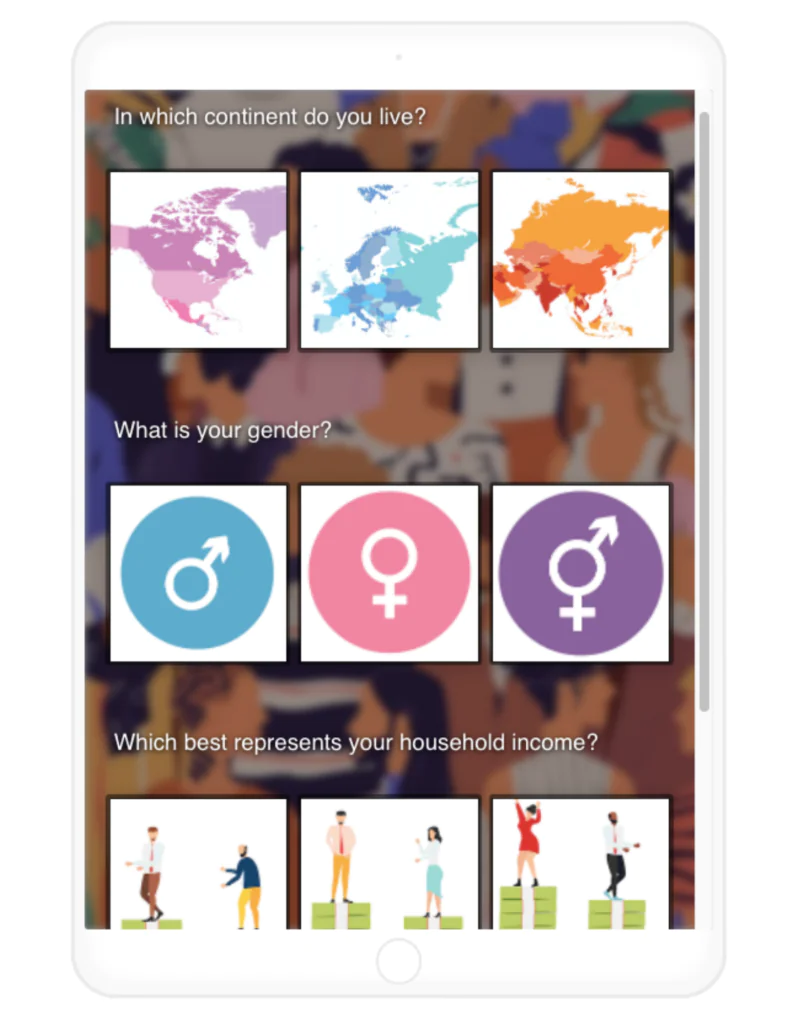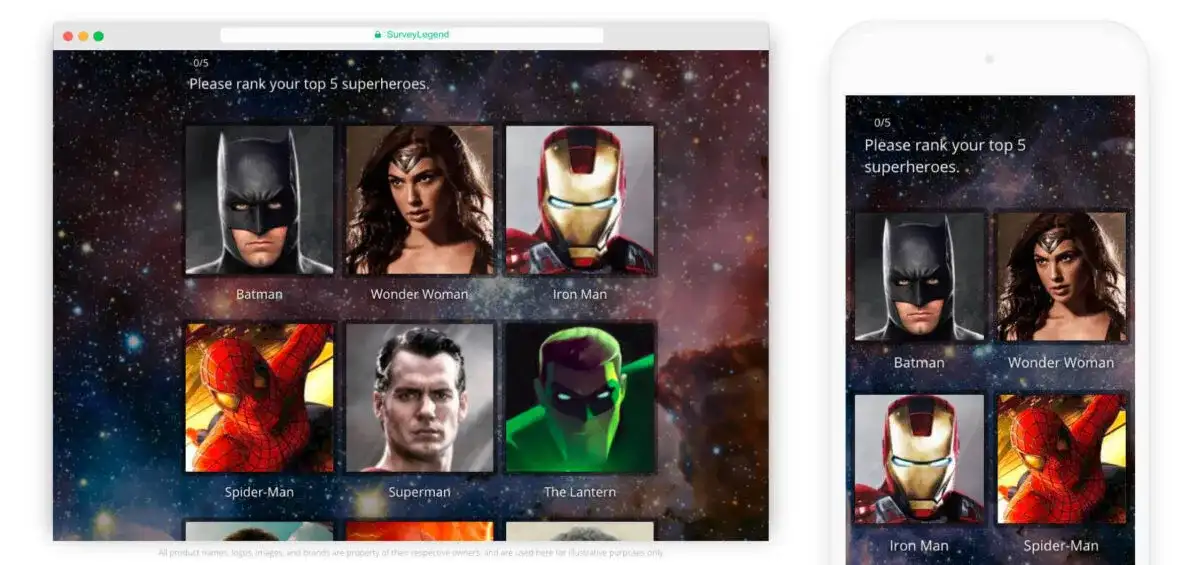British rockers The Who once sang, “Who are you? Who who, who who? I really want to know!” The lyrics to that song capture exactly what demographic survey questions are trying to get to the bottom of! Of course, these types of questions can be sensitive to some survey participants. So, it’s important to have a reason for asking demographic questions, and then going about asking them in the right way.
Create your demographic survey, form, or poll now!
What is Demographics?
Demographics is the analysis of a population’s characteristics (or a subset of that population). Demographic questions may be asked by government agencies, private research firms, broadcast media, websites, and consumer surveys. Often, demographics are key to creating targeted marketing campaigns that appeal to specific groups of consumers. With a better understanding of their consumer, companies can craft targeted advertising campaigns that are generally much more effective than “shotgun-style” mass marketing efforts that try to appeal to everyone. Demographics are also popular in politics; in 2012, Barack Obama made a demographic gamble, appealing to younger generations, and that paid off big time.
Of course, there is an entirely different line of research – psychographic studies – which try to uncover the beliefs, feelings, thoughts, biases, and other psychological factors that motivate people. But when it comes to demographic studies, just remember The Who. Who are you? What motivates you can come later.
Why Ask Demographic Questions?
Regardless of your industry, it’s important to understand just who is paying attention. Are you developing new products? Running for office? Starting up a company? If you conduct a survey to gauge response, you’ll want the demographic data of survey respondents to steer your initiatives in the right direction.
Demographic questions, sometimes known as screening questions, are particularly useful if you’re looking to gather some background information about people. When used properly, demographics allow you to get to know your target audience, making it easier for you to communicate with them and meet their needs.
15 Types of Demographic Questions to Consider, Examples, & How To Ask Them
Asking demographic questions is one thing, but obtaining the actual information is another. Questions about peoples’ personal lives can leave them uncomfortable and may cause them to opt out of your survey. So, it’s important to understand the reasons for asking certain demographic questions (a good rule of thumb is to ask as few as possible, only asking for must-have information) and knowing how to ask them.
1. Age
Age is a very common demographic question regardless of the topic, as it can impact a person’s attitudes, health, hobbies, politics, and purchases. A multiple-choice format with ranges for each answer is the most typical way to ask the question, as it does leave some room for privacy by not pinpointing an exact number.
Example: “What is your age?”
- Under 18
- 18 – 29
- 30 – 45
- 46 – 59
- Over 60
- Prefer not to answer
When creating age-related demographic questions, age ranges will differ based on the survey topic; for example, you’re likely to focus on breaking down the ranges of the younger demographic in a video game survey, while breaking down the ranges of the older demographic retirement planning survey.
Pro-Tip: Just as age ranges are used to maintain some privacy, you should not ask for a specific birth date or year. This is seen as too intrusive and likely to turn off participants.
2. Gender
Gender is a standard demographic question, for sure, but it should be approached in a sensitive way since it can be a complicated topic. Today, there are more than two accepted gender roles in modern society so instead of just asking what the respondent’s gender is, ask “what gender do you identify as?”
Example: “What gender do you identify as?”
- Male
- Female
- Transgender
- Non-binary
- Prefer not to answer
- Other
Be sure to always use the word “gender” and not “sex.” The American Psychological Association differentiates between gender and sex as follows: “Gender is cultural and is the term to use when referring to women and men as social groups. Sex is biological; use it when the biological distinction is predominant.”
Because most surveys are intended for market research, you’ll be looking for the gender a person identifies as. Gender is more perspective-based, providing flexibility for the participant.
3. Ethnicity
Cultural backgrounds and their traditions can play a large part in an individual’s attitudes, beliefs, and purchase behavior. However, this topic has become more politically charged than ever, so if possible, you may want to avoid asking it altogether. If you feel it’s necessary for proper research, we suggest creating checkboxes that allow participants to check as many answers as they want; after all, America is a melting pot.
Example: “Please specify your ethnicity (check all that apply)”
- Caucasian
- African-American
- Latino or Hispanic
- Asian
- Native American
- Native Hawaiian or Pacific Islander
- Other/Unknown
- Prefer not to say
As with all sensitive demographic questions, it’s important to give respondents the ability to refrain from answering.
4. Education
Education is an important demographic as it offers insight into the type of work a participant may be doing and how much they may be earning. In addition, people’s life perspectives and political beliefs often change based upon their level of education. Understanding education levels will also help when determining messaging; for example, someone with a master’s degree in business may not need to be told the basics of an investment strategy, while an electrician probably doesn’t need to know how circuitry works.
Be sure to always include options for trades and apprenticeships; simply focusing on degrees is likely to turn off those participants, as it assumes their post-high school efforts weren’t worthy of recognition.
Example: “What is the highest degree or level of education you have completed?”
- Some High School
- High School Diploma
- Bachelor’s Degree
- Master’s Degree
- Ph.D. or higher
- Trade School
- Apprenticeship
- Prefer not to say
5. Employment
A participant’s employment status gives researchers insight into their buying power, and often an employed person will have a significantly different take on questions than an unemployed person. Of course, some participants will think their employment status is none of your business or may be afraid that somehow information will get back to their employers and could cause them trouble. So, always provide an out.
Example: “What is your current employment status?”
- Employed Full-Time
- Employed Part-Time
- Self-Employed
- Seeking Opportunities
- Retired
- Prefer not to say
Remember to include the “self-employed” option, which is increasingly popular in today’s gig economy, and use “seeking opportunities” rather than “unemployed” as the latter can make respondents feel that you think they are lazy. The best demographic survey questions are non-judgemental!
6. Location
Location is a popular demographic question as it can impact a person’s life perspective (think rural versus urban lifestyles, or US-based individuals versus those living abroad). By understanding where your audience lives, you may be able to pinpoint who they may vote for, for example, or what types of products they would consider buying. Demographic information related to location can also help you find new markets to expand into.
Example: “Where is your home located?”
- North America/Central America
- South America
- Europe
- Africa
- Asia
- Australia
- Caribbean/Pacific Islands
- Other: ______
- Prefer not to say
Want to get really specific? Just narrow down the options based on where you’re surveying:
Example: “Where do you live?”
- New York
- Illinois
- Michigan
- Florida
- Texas
Pro-Tip: Don’t ask for a specific address unless there is a transaction involved or you are shipping something to the participant. Anything other than country, state, city, and county will appear shady to most participants and cause them to walk away.
7. Marital Status
Why does it matter if someone is married? Well, marital status helps researchers understand who participants are interacting with during their everyday lives. For example, a married person’s spending habits, and the places they frequent, may be very different from that of a single person.
Example: “Are you married?”
- Yes
- No
- In a domestic partnership
- Prefer not to say
It’s a good idea to include the “domestic partnership” option as some couples simply don’t like the concept of marriage, but live together as if they were married. Additionally, some same-sex couples in certain countries are not legally allowed to marry but may live together as if they were and are for all intents and purposes, married.
8. Sexual Orientation
Understanding the sexual orientation of adults has become more important over the years for health, economic, and social surveys. Of course, retailers and brands also want to know what percentage of their audience is gay, lesbian, or bisexual for consumer-focused campaigns.
While questions around education and employment may be able to tiptoe around asking income questions, there’s no demographic question that will really let a researcher know if the participant identifies as lesbian, gay, or bisexual without just asking. So, if you need to know, just ask:
Example: “What is your sexual orientation?”
- Heterosexual/Straight
- Homosexual/Gay or lesbian
- Bisexual
- Other
- Prefer Not to Answer
You’ll note that transgender and non-binary are not included here as they were in the gender category. That’s because they are not considered “orientations,” but rather how someone identifies.
For more on this topic check out the UCLA Williams Institute Report.
9. Household Income
Household income, or HHI, reveals how much income is being earned by everyone under the same roof. This sum includes the participant’s income, their spouse’s, and any other people living in their house. Collecting this information helps researchers understand the amount of buying power potential customers control.
As with most questions, this can be seen as “none of your business,” so always use a range to soften things, and always offer an out or you could lose perfectly good participants for nothing.
Example: “What is your annual household income?”
- Under $25,000
- $25,000 – $49,000
- $50,000 – $74,000
- $75,000 to $99,000
- Over $100,000
- Prefer not to say
10. Language
¿Habla usted inglés? Pratar du engelska? 英語を話せますか… Understanding your customers’ first language helps build a stronger relationship with them. It can also reveal some important cultural details about them. Remember, just because two participants are from the same place, doesn’t mean they speak the same language – especially in a melting pot like the United States. Their language differences can impact their values, customer needs, and goals.
As with ethnicity, we suggest creating checkboxes that allow participants to check as many answers as they want since they may speak many languages fluently.
Example: “Which languages can you speak fluently? (Check all that apply)”
- Arabic
- English
- French
- German
- Italian
- Japanese
- Mandarin
- Russian
- Spanish
- Swedish
- Other
Pro-Tip: There are thousands of languages in the world but over half the world’s population speaks just 23 languages. Remember this when tailoring your survey questions to match the expected target audience in your survey.
11. Birthplace
A person’s birthplace can reveal significant details about their life. For example, someone born in one country who then moved around the world may have been reacting to professional, political, or social factors. This can have a serious impact on their wants, needs, and expectations as a customer.
Example: “Where were you born?”
- North America/Central America
- South America
- Europe
- Africa
- Asia
- Australia
- Caribbean/Pacific Islands
- Other: ______
- Prefer not to say
Some researchers find birthplace to be an unnecessary piece of information; after all, the participant moved away from there and is living a new life elsewhere. Others find it important because of cultural leanings. Ultimately, it will depend upon the type of survey you’re conducting.
12. Political Affiliation
Do you want to know a person’s political affiliation? It’s best to just come out and ask, as always, with an out.
Example: “Which political party are you part of?”
- Democratic Party
- Republican Party
- Independent
- Prefer not to answer
If you’re more interested in where they stand on certain issues, you may want to ask about their political view rather than their political party.
Example: “How would you describe your political view?”
- Very Liberal
- Slightly Liberal
- Neither Liberal nor Conservative
- Slightly Conservative
- Very Conservative
- Prefer not to say
13. Voting Status
Just because someone identifies with a political party, doesn’t mean they’re actively voting. This demographic question is designed to determine if a person is active in local or national politics. The question can be asked in general, or can be tied to a particular area as seen below:
Example: “Are you registered to vote in ____?”
- Yes
- No
- Prefer not to say
14. Family and Dependents
Kids play a huge role in the purchasing decisions of their parents (and also can influence their attitudes and personal values). So, customers with children are going to have different needs than those who don’t. For researchers, it’s important to understand these differences in order to appeal to their audience. This applies to everything from a political campaign to the release of a new toy!
Example: “How many children do you have?”
- 0
- 1
- 2-4
- 4+
- Prefer not to say
Unless you’re running some sort of sweepstakes in which names are necessary, remember it’s not a good idea to ask for specifics about any child; even just their name is generally off-limits. Asking these kinds of questions is usually unnecessary and they are bound to raise a red flag with parents.
15. Religion
Religion can dramatically impact the moral values of your customers, whether you agree with them or not. Religions can determine the kind of people they associate with, the types of foods they’ll eat, the type of clothing they’ll wear, and the type of entertainment they’ll consume.
Religion, like politics, can be a hot-button issue that’s best avoided if possible. If understanding the religious beliefs of participants is important, just remember to always provide “other” and “prefer not to say” options. Since many people aren’t religious at all, you could begin your question with “if applicable,” or provide “non-religious/non-practicing” as an option.
Example: “If applicable, please specify your religion.”
- Catholicism/Christianity
- Judaism
- Islam
- Buddhism
- Hinduism
- Other: ______
- Prefer not to say
Demographic Survey Pictures
Let’s face it, demographic questions can get boring, and most survey respondents have been asked them hundreds of times adding to the tediousness of answering them. One way to make your demographic survey more engaging is to use demographic survey pictures. When you ask questions with pictures, you ensure that the question is being communicated properly. This is especially important when the survey is being sent to an area where many languages are spoken.
For example, in the U.S., California is the most linguistically diverse state, with more than 220 languages spoken. So, if you’re looking to survey Californians, simply sending a survey in English may not work. Using survey pictures, however, gets the message across regardless of language. Below is an example of how to ask questions with pictures when conducting a demographic survey.
Conclusion
Not everyone is going to want to answer your demographic questions. The best way to gain their participation is to explain the purpose of the survey upfront and what the data will be used for. If your survey is anonymous and secure, you’ll want to emphasize this as well. Participants have nothing to fear by providing demographic information if they know their information is confidential and protected. For more ways to increase survey participation, check out our blog 10 Ways to Improve Survey Response Rates.
Ready to begin creating your demographic survey? Get started now with SurveyLegend. Our pre-designed templates are easy to use and easy on the eyes. They’re also secure, so you can gain peoples’ trust and participation. Sign up today!
Any demographic survey questions you think we missed? Any advice of your own on how to ask demographic questions on a survey? Let us know your thoughts in the comments!
Create your demographic survey, form, or poll now!
Frequently Asked Questions (FAQs)
Demographics is the analysis of a population’s characteristics (or a subset of that population). Demographic questions are often asked on surveys in order to understand a participant’s background.
Demographic questions help researchers gather background information about people in order to make informed decisions when communicating with or marketing to a particular audience.
Demographic questions should be placed at the top of a survey. This weeds out unqualified candidates immediately, saving time during analysis.
While most surveys will never use them all, there are 15 demographic questions considered standard: Age, Gender, Ethnicity, Education, Employment, Location, Marital Status, Sexual Orientation, Household Income, Language, Birthplace, Voting Status, Family/Dependents, Religion, and Political Affiliation.




